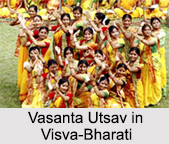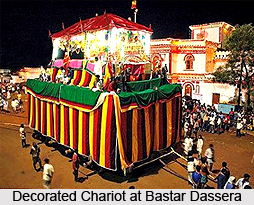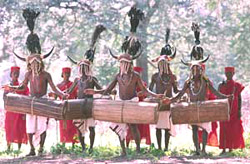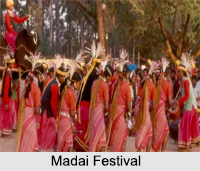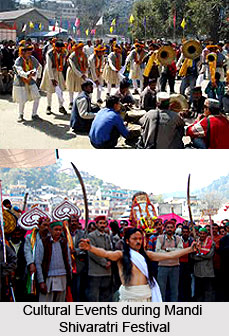 Mandi Shivaratri Fair is a yearly fair which is celebrated for an entire week during the Hindu festival, `Shivaratri` in the region of Mandi, Himachal Pradesh during February or March. The fair is held during the `Krishna Paksha` in `Phalguna` month, according to the Hindu calendar and since the festival is immensely popular throughout the nation and also overseas, presently it has been termed as an international festival. On account of the numerable deities of their 81 temples who are invited to the venue of this festival, Mandi is often called the `Varanasi of the Hills`.
Mandi Shivaratri Fair is a yearly fair which is celebrated for an entire week during the Hindu festival, `Shivaratri` in the region of Mandi, Himachal Pradesh during February or March. The fair is held during the `Krishna Paksha` in `Phalguna` month, according to the Hindu calendar and since the festival is immensely popular throughout the nation and also overseas, presently it has been termed as an international festival. On account of the numerable deities of their 81 temples who are invited to the venue of this festival, Mandi is often called the `Varanasi of the Hills`.
From the day of Shivaratri onwards, above 200 Gods and Goddesses are believed to assemble at Mandi town during Mandi Shivaratri Fair, which transforms into a region of grand festivities and attraction during this point of time. Situated on the banks of Beas River, the town of Mandi is one of the most ancient towns of Himachal Pradesh and is often referred to as the `cathedral of temples` as it possesses 81 temples. This festival is associated to many legendary tales and Lord Shiva of the Bhootnath Temple and Lord Vishnu or `Madho Rai` or Lord Vishnu are the main presiding deities of the festival.
History of Mandi Shivaratri Fair
Raja Akbar Sen used to reign over the region of Mandi town and he is said to have been the earliest great ruler of Mandi in the 16th century. It is believed that this Indian ruler extended his royal empire by invading new areas since he aimed to govern a greater stretch of land than what were his ancestral estates. He had erected the Bhootnath Temple at the central part of the Mandi which is one of the principal focal temples which are associated to Mandi Shivaratri Fair. The practise of worshipping Lord Shiva and related deities started gaining popularity during this point of time, including the worship of Lord Vishnu, particularly during the rule of Raja Suraj Sen. The Madhav Rai Temple which is dedicated to Lord Vishnu was established as the `protector deity of Mandi` and it was installed by Raja Suraj Sen during the period from 1664 till 1679. His goldsmith had built the idols of Lord Krishna and Radha with the aide of silver during the year 1705 which had been termed as `Madho Rai`. From that time onwards, various kings of this region ruled the state, as servants of Madho Rai. The presiding deity of Madhav Rai Temple was treated with utmost respect and reverence by the successors of Suraj Sen. The residents of this part of the country are known to be theocratic and it is clearly depicted through the Mandi Shivaratri Fair which is observed every year with great amidst great pomp.
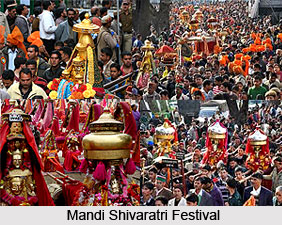 It is believed that Ishwari Sen is directly related to this famous festival, who was imprisoned for a long period of 12 years following his defeat in the battle launched by Sansar Chand of Punjab during 1792. Later Gurkha invaders who attacked Mandi states and Kangra set him free and eventually recovered Mandi state, transferring imperial power to Ishwari Sen. To mark his return to his own state capital at Mandi, a grand reception was organised. The new ruler of Mandi, Ishwari Sen then invited all the deities of the hillsides of his kingdom and arranged a great event to celebrate his success, in gratitude to the deities for his good luck. This very day is observed today as the Mandi Shivaratri festival day. Since that time, the Mandi Shivaratri Fair is organised here through nowadays, modern features have been introduced in this religious fair as Bollywood stars often perform at the fair, at Paddal, especially in the evenings.
It is believed that Ishwari Sen is directly related to this famous festival, who was imprisoned for a long period of 12 years following his defeat in the battle launched by Sansar Chand of Punjab during 1792. Later Gurkha invaders who attacked Mandi states and Kangra set him free and eventually recovered Mandi state, transferring imperial power to Ishwari Sen. To mark his return to his own state capital at Mandi, a grand reception was organised. The new ruler of Mandi, Ishwari Sen then invited all the deities of the hillsides of his kingdom and arranged a great event to celebrate his success, in gratitude to the deities for his good luck. This very day is observed today as the Mandi Shivaratri festival day. Since that time, the Mandi Shivaratri Fair is organised here through nowadays, modern features have been introduced in this religious fair as Bollywood stars often perform at the fair, at Paddal, especially in the evenings.
Rituals of Mandi Shivaratri Fair
The inhabitants of Mandi pay tribute to God Madhav Rai and Raja Ishwari Sen by carrying the different village deities on beautifully decorated chariots or `rathas`, also known as palanquins, on the holy occasion of Shivaratri. Some of the deities are also transported inside vehicles by certain castes. Each holy deity brought here are adorned with glamorous and richly embroidered drapery, after which they are carried to the Madhav Rai Temple for their prayers to Lord Shiva and then to Lord Vishnu. Thereafter, they march towards the palace of the king in a smart procession regionally famous as the `Zareb` or `Shoba Yatra` in order to honour the Raja, who is revered throughout the area as the `regent of Lord Madhav Rai`. People dwelling here are of the view that Madhav Rai steps outside His temple premises only once in the entire year on the day of Mandi Shivaratri and leads the long procession. The chariots of the deities are swayed rhythmically to folk music and drum beats to symbolise their glee after paying visit to Bhootnath Temple of Lord Shiva and Madhav Rai Temple of Lord Vishnu.
A unique `pecking order` is followed in the festival on the second day of the fair in which the various deities are assigned places at the grounds of Paddal, where they are worshipped with great devotion by the assembled pilgrims. About 200 deities of shrines spread across Mandi are brought to the venue of the fair, arranged as per their social status and rank, amidst the folk dancers, folk bands and devotees who are all clad in attractive costumes. The spot known as Paddal is an extensive open area at the intersection of Suketi and Beas Rivers. Several regional traders and local inhabitants conduct brick trade from places like Bilaspur, Shimla and Kangra in walnuts, ghee, honey, opium and many other products. Commercial activities are also maintained from regions in Punjab. The handcrafted local ornaments manufactured in this region are exhibited and promoted through the Mandi Shivaratri Fair, though the fair mainly concentrates on religious themes.
`Jagaran` or night-long worship is conducted on the second-last day of Mandi Shivaratri, when several dances and music are enjoyed by the devotees. A saint and his disciple declare prophecies regarding the next year during the festival and on the final festive day prayers are offered to Lord Shiva while the several deities who were ushered to the venue are returned to their original temples. `Chadars` or sacred draperies are respectfully offered to God and the Governor of the state attends this worship after which he accompanies pageant. It is firmly believed that the regional God of Rains known as `Rishi Kamru Nag` who is the chief deity of Shivaratri Fair proceeds to Tarna Hill, close to Tarna Maa Temple to observe the proceedings of the fair for seven days. People belonging to many parts of the nation and different sections of the society are present in this fair to invoke the blessings of Lord Shiva. Mandi Shivaratri Fair 2014 will be observed from 28th February, 2014.

